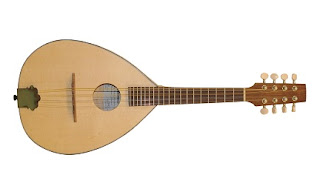 |
| Mandolin |
It didn't take much thought for the staffer who turned up this dreck to realize that Mithra knew squat about mandolins before attempting to reword a Wikipedia or Encyclopedia Britannica entry on the topic. This passage is a dead giveaway:
"As part of the chordophone family, the mandolin is a specific kind of lute. The sound of chordophone instruments comes from vibrating strings. The mandolin, and its neighboring [sic] mandola and bouzoukis, qualify as citterns because they are plucked with a plectrum... [bolding ours]"
Our more musically-inclined staffers know that there are multiple technical terms [in bold] in that passage that would be even more unfamiliar to someone unfamiliar with the instrument in question. As for "neighboring," who knows what that was supposed to mean! If that weren't enough, however, the subsequent paragraph was even more indicative of S's musical illiteracy:
"Mandolin strings are tuned in unison and differ from the next pair by a fifth of a note."
Besides the fact that Mithra's wording is ambiguous – each pair of mandolin strings is tuned in unison – two pair of strings are separated by a musical fifth, not a "fifth of a note" (whatever that might be). Technically speaking, a musical fifth is a ratio of frequencies: the frequency of any note's fifth is 3/2 the frequency of that note. For example, on a piano Middle C and the G above Middle C are fifths. In contrast, the note corresponding to "a fifth of" Middle C is a G slightly more than two octaves below Middle C.
By and large, Mithra failed miserably at describing a mandolin. While s/he managed to mention four pairs of strings and an "almond-shaped" body, S. said nothing about the following:
- How big is a mandolin? The typical mandolin is about fourteen inches long.
- Are there frets? Mandolins, like guitars (but unlike violins), are fretted.
- Do mandolins use steel or gut strings? Mandolins use steel strings, usually round wound.
- How are mandolins generally played? Mandolins are usually rhythm instruments, although top players like Chris Thile and David Grisman use them as lead (melody) instruments.
Instead of describing the mandolin, Mithra instead chose to regurgitate (semi-coherently, at that) factoids about the instrument's history (with an overemphasis on vaudeville, in our view). Whatever the case, it's patently obvious that our Dumbass of the Day knew nothing about mandolins in specific when he/she/they wrote this back in 2005, and very little (if anything) about music in general.
¹ We would be remiss if we did not mention that there is a kitchen appliance known as a mandoline, but pronounced the same as the musical instrument.
SE - MUSIC
No comments:
Post a Comment